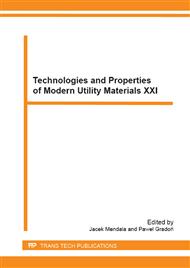p.39
p.45
p.49
p.53
p.59
p.63
p.67
p.71
p.75
Physical and Mechanical Properties of Composites with Aluminum Alloy Matrix Designed for Metal Forming
Abstract:
The change of matrix and usage of the aluminum alloys designed for the metal forming in making the composite suspension allows to extend the processing possibility of this type of materials. The possibility of the metal forming of the composites obtained by mechanical mixing will extend the range of composite materials usage. Applying of the metal forming e.g. matrix forging, embossing, pressing or rolling, will allow to remove the incoherence of the structure created while casting and removing casting failures. In order to avoid the appearance of the casting failures the homogenization conditions need to be changed. Inserting the particles into the matrix influences on the shortening of the composite solidification. The type of the applied particles influenced the sedimentation process and reinforcement agglomeration in the structure of the composite. Opposite to the composites reinforced with one-phase particles applying the fasess mixture (glassy carbon and silicon carbide) triggered significant limitation in the segregation process while casting solidification. Inserting the particles into the AW-AlCu2SiMn matrix lowers the mechanical properties tension and impact value strength. The most beneficial mechanical properties were gained in case of heterofasess composites reinforced with the particle mixture of SiC and glass carbon. The chemical composition of the matrix material (AW-AlCu2SiMn) allows to increase additionally mechanical characteristics by the precipitation hardening reached through heat casting forming.
Info:
Periodical:
Pages:
59-62
Citation:
Online since:
December 2013
Authors:
Price:
Сopyright:
© 2014 Trans Tech Publications Ltd. All Rights Reserved
Share:
Citation:


